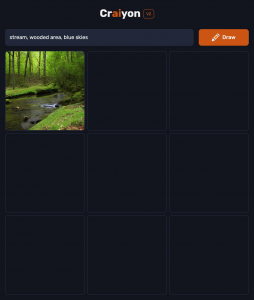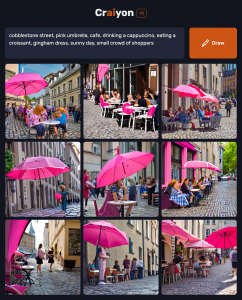Craiyon Images
The more accurate:



The note so accurate:

Reflection
Overall, the results were relatively accurate and the images were somewhat close to what I imagined when selecting my prompts. I chose to include four different prompts. The first two were relatively simple and included only a few prompts. The images produced were similar to what I had imagined. However, the last two were not what I imagined. The first of the two was very simple with the prompt “vacation”, the last was complex, including many details: “cobblestone street, pink umbrella, cafe, drinking a cappuccino, eating a croissant, gingham dress, sunny day, small crowd of shoppers; this image was the furthest from what I imagined, however, it wasn’t completely off.
The Process
When ‘playing’ around with AI ‘games’ such as Craiyon, we tend to forget some of the important factors of AI. It’s fun. Craiyon is a reminder how efficient and quick AI can be at finding patterns at a quicker pace than humans could ever, it is because of this AI is useful and will always be so (such as for medical and scientific breakthroughs) (Santa Clara University, 2018).
Craiyon, like most simple AI, processes massive amounts of data (mainly images), it looks for patterns to model in their own decision-making and then comes up with a compiled image based on the prompts given (Schroer, 2023). With Craiyon, no information from the user is needed to access, therefore the likelihood of data stored from their users is small. Additionally, Craiyon does not check with its users to gather feedback on the images presented, therefore, I wondered if this would support Craiyon’s improvement? It appears that Craiyon utilizes similar search results from a variety of databases in order to compile the images.
We tend to view AI as only very good or very bad, but forget the inbetween (which is occurring every day). However, after listening to The Crime Machine (Vogt, 2018) as well as reading O’Neil (2017), although these algorithms may have the best of intentions, it’s important to remember as we’re ‘playing around’ or ‘having fun’, the world of algorithms is still very new and highly risky new industry with no safety precautions, rules or regulations in place (O’Neil, 2017). As algorithms change rapidly is it even possible to keep them safe and regulated? And the algorithms that are working, as highlighted by Vogt (2018) how often should an algorithm be revisited to ensure that it is still beneficial? And who should be responsible for ‘checking in’ on these algorithms to ensure safety? Lee at. Al. (2018) suggested in their research a framework for algorithmic hygiene, which highlights some specific causes of biases and offers best practices to identify and solve them (you can read more about that here). It was also suggested that public policy is important in promoting the fair and ethical deployment of AI and machine learning technologies (Lee et. al., 2018). My hope is that the dialogue on AI progress continues in order for continuous development, redevelopment and improvement to continue, by doing so there will be a space available for fun and learning that is safe for all.
References
Lee, N., Resnick, P., & Barton, G. (May 22, 2019). Algorithmic bias detection and mitigation: Best practices and policies to reduce consumer harms, Brookings. https://www.brookings.edu/research/algorithmic-bias-detection-and-mitigation-best-practices-and-policies-to-reduce-consumer-harms/
Santa Clara University. (2018, November 6). Lessons from the AI Mirror Shannon Vallor. YouTube.
Schroer, A. (March 3, 2023). Artificial intelligence: what Is artificial intelligence (AI)? How does AI work?. Built In. https://builtin.com/artificial-intelligence
Vogt, P. (2018, October 12a). The Crime Machine, Part I (no. 127) [Audio podcast episode]. In Reply All. Gimlet Media.
Vogt, P. (2018, October 12b). The Crime Machine, Part II (no. 128) [Audio podcast episode]. In Reply All. Gimlet Media.
Petros Katsigiannis
April 6, 2023 — 8:01 pm
Hello Dana! I agree with you that AI is a lot of fun to play with. I do find that at times there are inaccuracies, but the fact that it is able to produce results that are mostly what we are looking for is impressive. As the readings and media in the module mentioned, GPT has already started creating a variety of material (pictures, chats, exams, essays) and sooner rather than later AI such as Craiyon will be able to create near real or even real pictures. The model based on the results is that AI keeps on improving (Heilweil,2022). I don’t know if this is a good or bad thing, but what I do know is that AI is moving at a very fast pace. Thank you for your post !